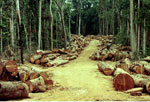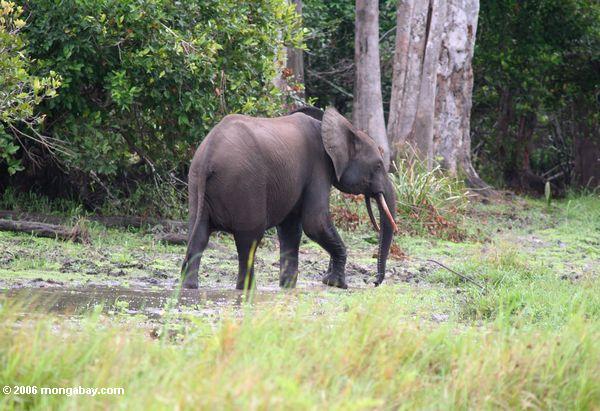DNA evidence has shown that the forest elephant-Africa’s smaller, shyer pachyderm-is indeed a separate species from the much more well-known savanna elephant. While scientists have long debated the status of the forest elephant (should it be considered a separate population, a subspecies, or a unique species?) a new study in the open-access journal PLoS Biology finds that genetically the forest elephant is unarguably a new species. If conservation authorities accept the new study, it will change elephant conservation efforts throughout Africa.
“The surprising finding is that forest and savanna elephants from Africa—which some have argued are the same species—are as distinct from each other as Asian elephants and mammoths,” said co-author David Reich from the Department of Genetics at Harvard Medical School in a press release.
Professor Michi Hofreiter, who specializes in the study of ancient DNA in the Department of Biology at York, explains further: “The divergence of the two species took place around the time of the divergence of the Asian elephant and woolly mammoths. The split between African savanna and forest elephants is almost as old as the split between humans and chimpanzees. This result amazed us all.”
Even in outside appearance Africa’s forest and savanna elephant differ greatly. The savanna elephant is usually significantly larger than the forest: 3.5 meters shoulder height versus 2.5 meters and several tons heavier. In addition, the forest elephant’s ears are rounder and its tusks straighter than its savanna cousins.
“We now have to treat the forest and savanna elephants as two different units for conservation purposes,” says Alfred Roca, assistant professor in the Department of Animal Sciences at the University of Illinois. “Since 1950, all African elephants have been conserved as one species. Now that we know the forest and savanna elephants are two very distinctive animals, the forest elephant should become a bigger priority for conservation purposes.”
The IUCN Red List has not evaluated the forest elephant population separately from the savanna elephant, yet anecdotal evidence from scientists working with forest elephants sound deep warnings about their populations, which are threatened by habitat loss and poaching. Speaking to mongabay.com in 2009, Stephan Blake said, “Tell [your readers] that this is the last hurrah for forest elephants.”
Forest elephant in Gabon. Photo by: Rhett A. Butler.
Related articles
Vanishing forest elephants are the Congo’s greatest cultivators

(04/09/2009) A new study finds that forest elephants may be responsible for planting more trees in the Congo than any other species or ghenus. Conducting a thorough survey of seed dispersal by forest elephants, Dr. Stephen Blake, formerly of the Wildlife Conservation Society (WCS) and now of the Mac Planck Institute for Ornithology, and his team found that forest elephants consume more than 96 species of plant seeds and can carry the seeds as far as 57 kilometers (35 miles) from their parent tree. Forest elephants are a subspecies of the more-widely known African elephant of the continent’s great savannas, differing in many ways from their savanna-relations, including in their diet.
Forest elephants learn to avoid roads, behavior may lead to population decline
(10/27/2008) Forest elephants in the Congo Basin have developed a new behavior: they are avoiding roads at all costs. A study published in PLoS One concludes that the behavior, which includes an unwillingness to cross roads, is further endangering the rare animals which are already threatened by poaching, development, and habitat loss. By avoiding roads, the elephants are increasingly confining themselves to smaller areas lacking enough habitat and resources.
Congo forest elephants declining from logging roads, illegal ivory

(04/02/2007) Fast-expanding logging roads in the Congo basin are becoming ‘highways of death’ for the fierce but elusive forest elephant, according to a new study published in the journal Public Library of Science. Logging roads both provide access to remote forest areas for ivory poachers and serve as conduits of advancing human settlement.
